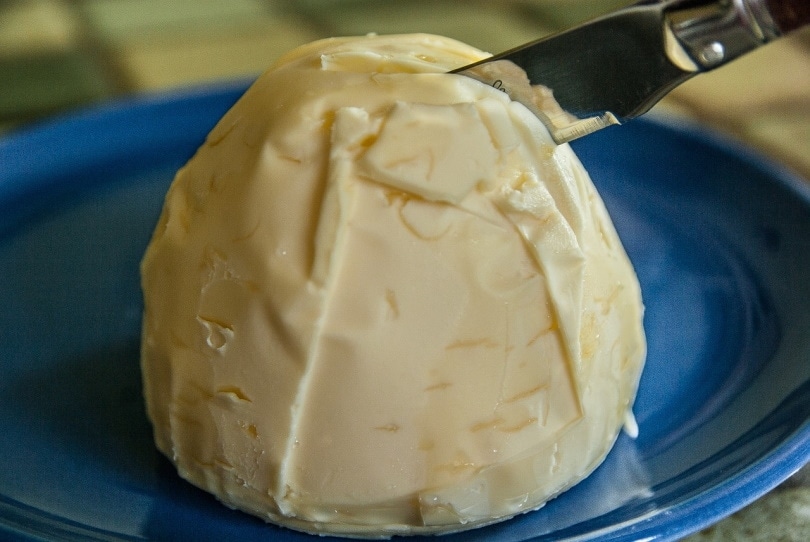Can Dogs Eat Margarine? Vet Approved Facts & FAQ
Updated on

Margarine is a common item in many people’s refrigerators. It’s often used in place of butter because of the perception that margarine is healthier for people than butter. Regardless of how healthy or not healthy it may be for humans, you’re probably going to be concerned if your dog manages to eat a pat of margarine from the floor before you’re able to clean it up. While the good news is that margarine is not a toxic food for dogs, it’s not a healthy food for them and they shouldn’t eat it. Margarine’s high oil content can lead to digestive upset and more serious conditions like pancreatitis, particularly when ingested in large amounts.
Is Margarine Safe for Dogs?
Margarine is a non-toxic food that dogs can technically consume. However, due to the high oil content of margarine, there is a high likelihood of stomach upset if your dog eats it. A pat of margarine is unlikely to be much of an issue for most dogs, but if your dog eats half of a tub of margarine, then you should be ready for gastrointestinal problems such as vomiting and diarrhea.
Margarine’s high-fat content can also trigger pancreatitis when eaten, which can cause serious illness. Pancreatitis is inflammation of the pancreas, and the signs often come on quickly and include vomiting, reduced appetite, and a painful abdomen.
If your dog eats a large amount of margarine, or you have any concerns about the signs they are showing, it’s best to at least call your vet to let them know what happened and get detailed information. Your dog’s vet will know their health status and history, so they’ll be able to gauge if your dog needs to be seen or if you can safely monitor your dog at home.

Is Margarine Good for Dogs?
Although safe in small quantities, margarine is not a healthy food for dogs. Unlike real butter, margarine is free of cream, but it still may contain some amount of lactose or whey, both of which can cause stomach issues for dogs. Margarine is made from a mixture of oils that are prepared in a way that mimics the texture and taste of butter. Just like you wouldn’t give your dog a bowl of vegetable oil, you shouldn’t feed them margarine.
It should be noted that there are some oils that are healthy for dogs in suitable amounts, like fish oil. The ingredients of margarine will vary depending on what recipe is used but they are primarily made from a blend of vegetable oils. These mostly contain unsaturated fat but the more solid the margarine, the more saturated fat it has in it. It’s not a good source of omega fatty acids or any vitamins or minerals, although fortified margarine is available that often has added omega-3 fatty acids and vitamins A and E. It is very high in calories and fat, with just 1 tablespoon (14.2 grams) containing around 102 calories and 11.5 grams of fat.
Over time, excess calories can lead to obesity and related health conditions in dogs, like diabetes. It’s extremely important that you limit high-calorie extras, like margarine, in your dog’s diet.
Margarine also often has added salt, additives, and preservatives, none of which are good for your dog’s health. Since this food has no nutritional value for your dog’s diet, it’s best to avoid it altogether.
In Conclusion
Margarine is not a healthy food for dogs, although it is not toxic to them. It’s best to avoid margarine in your dog’s diet since it has essentially no nutritional value for them and is likely to add too many calories and too much fat to their diet. If your dog consumes a large quantity of margarine, then you should touch base with your vet for further guidance.
Featured Photo Credit: JumpStory













